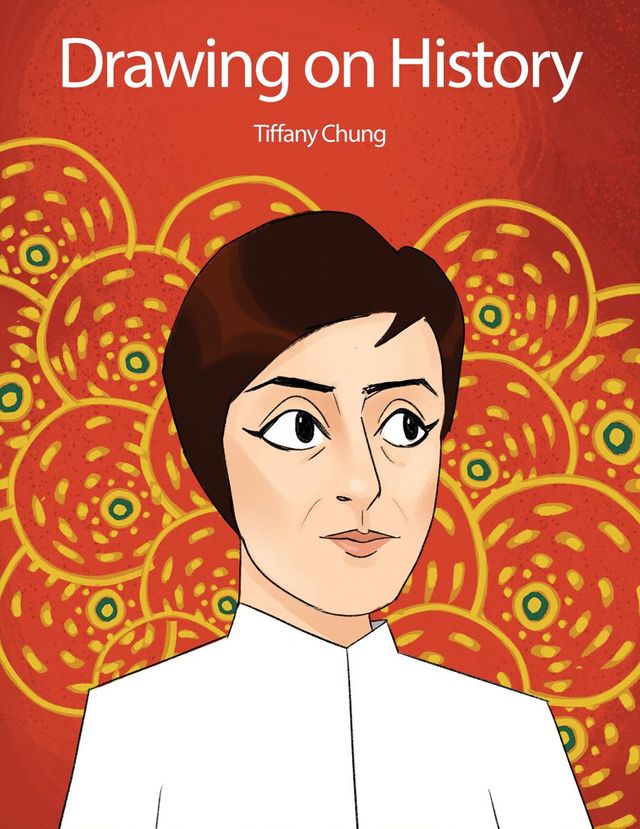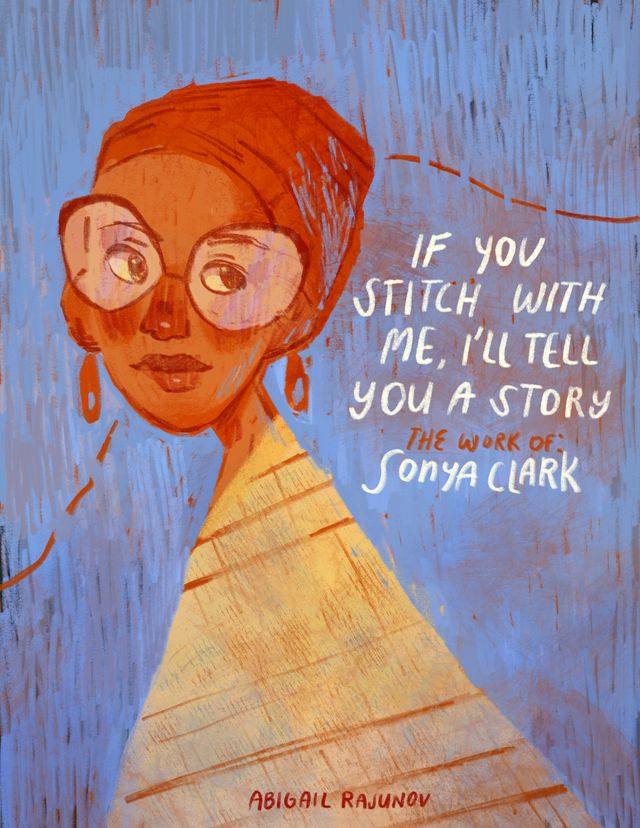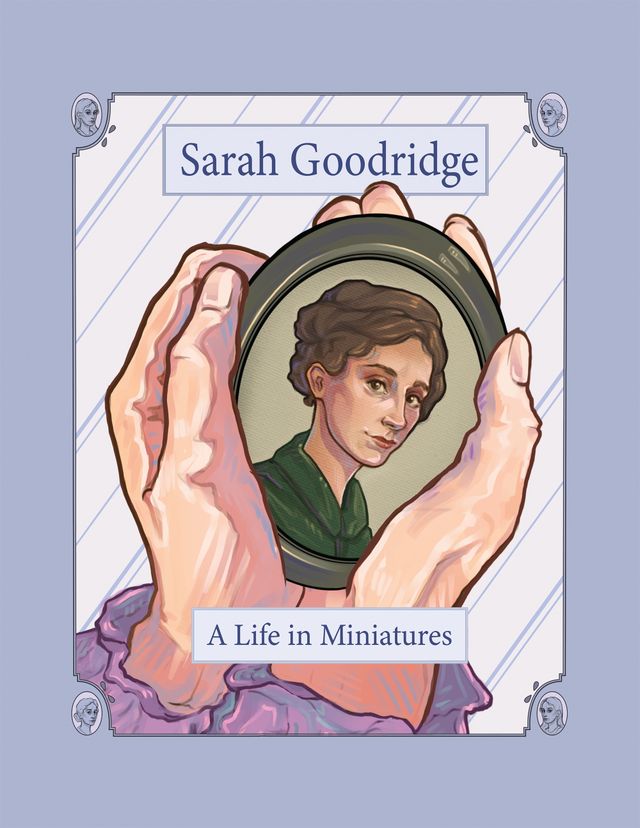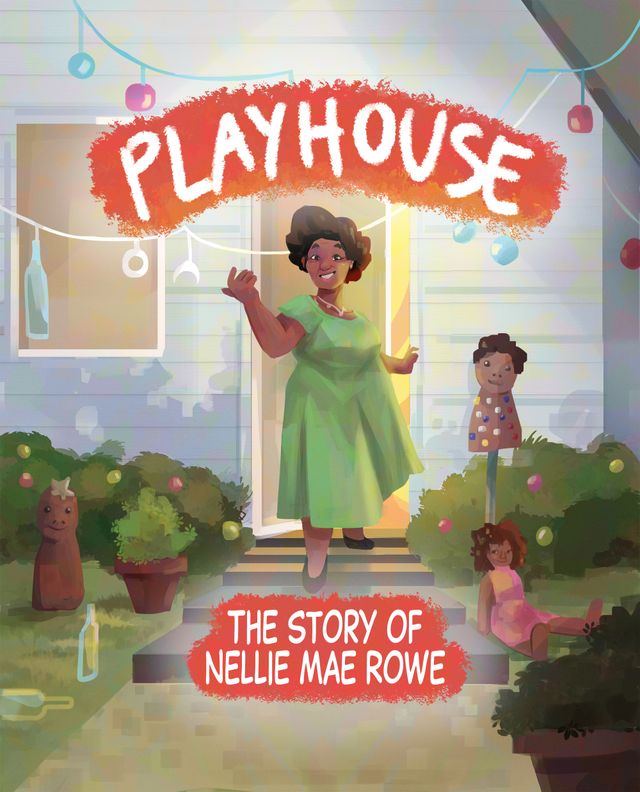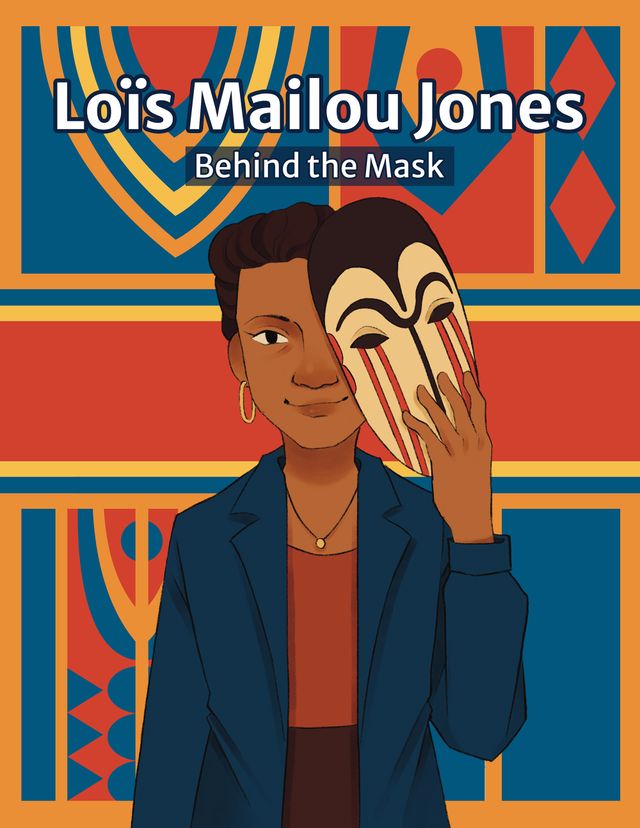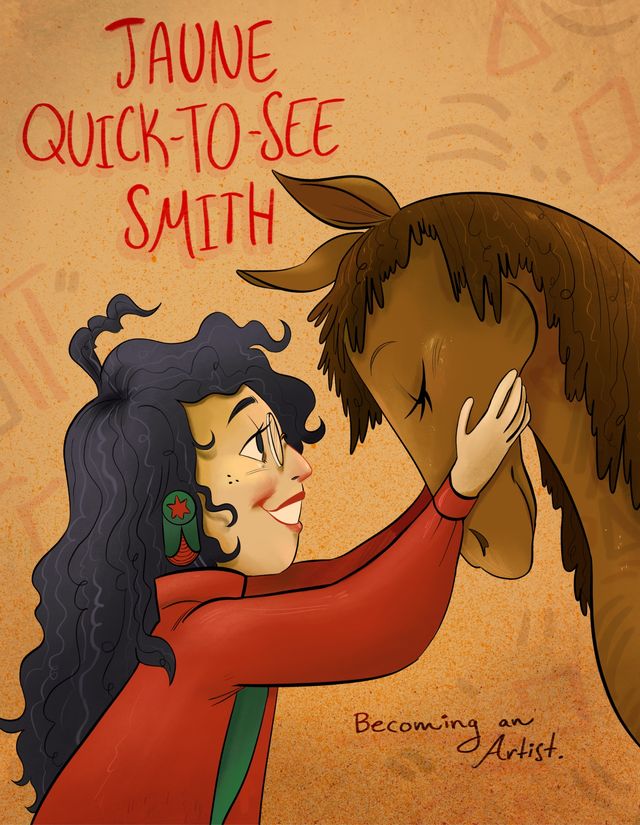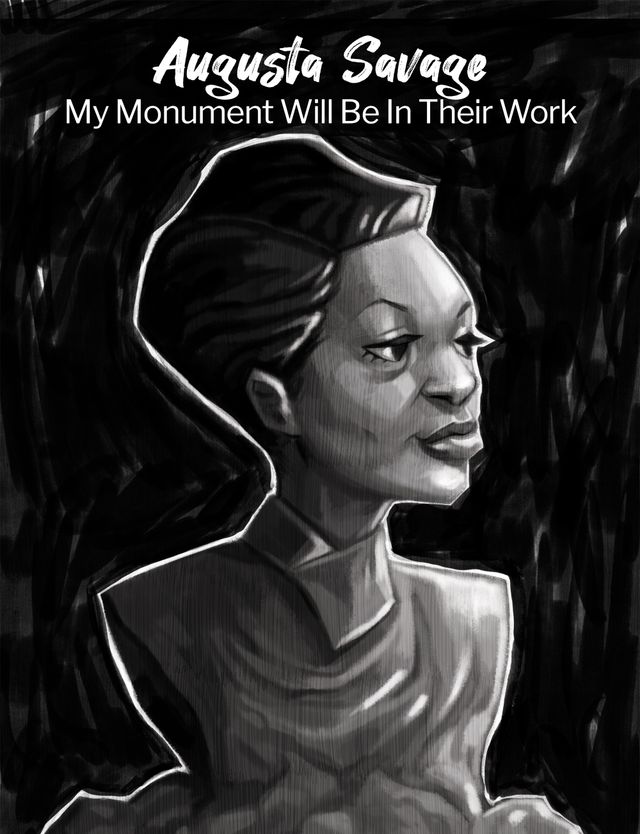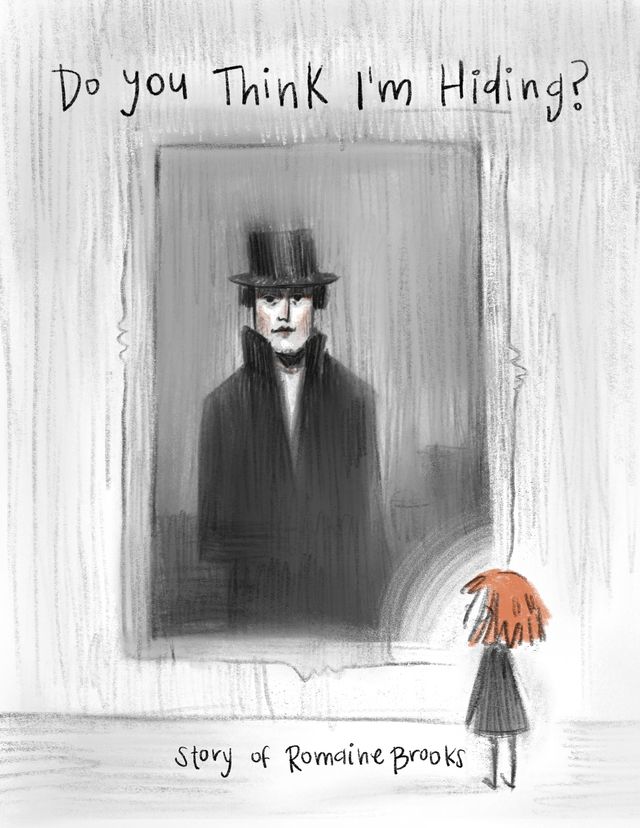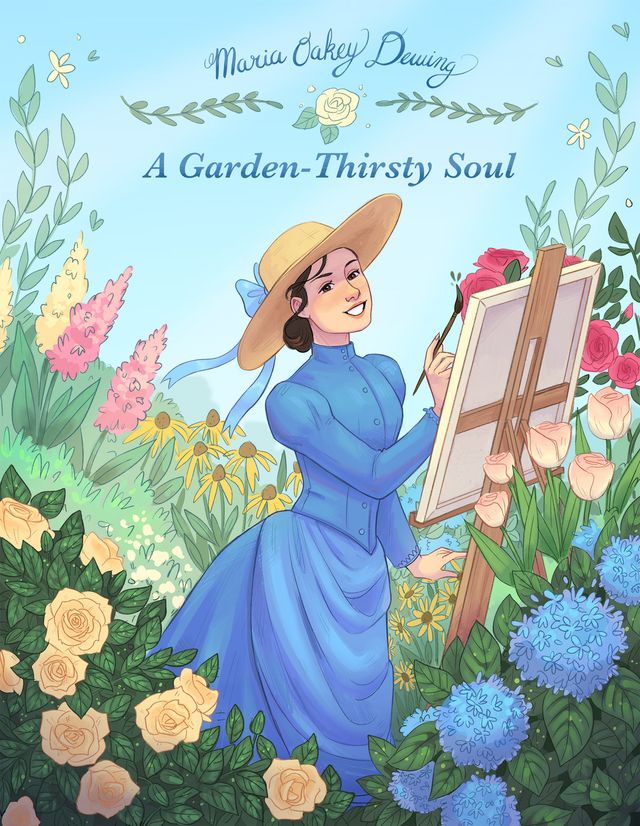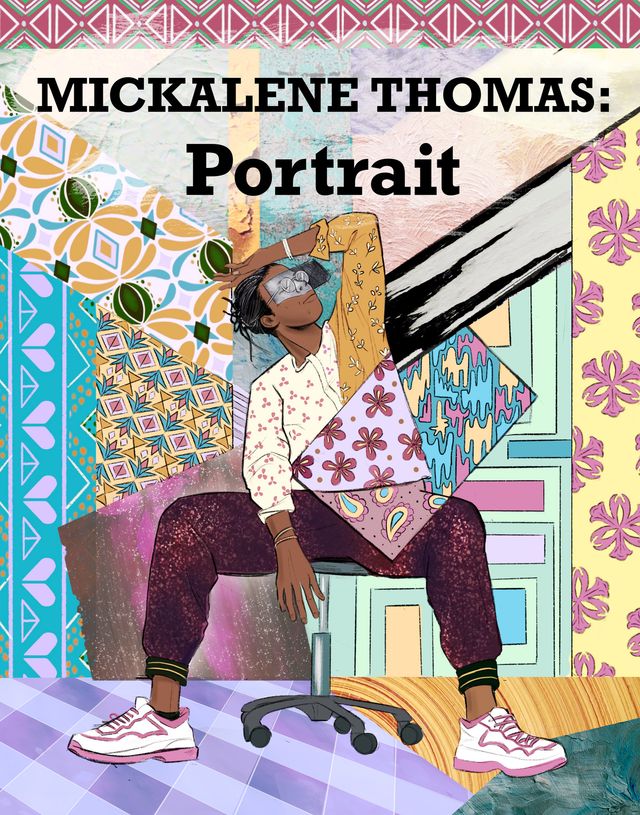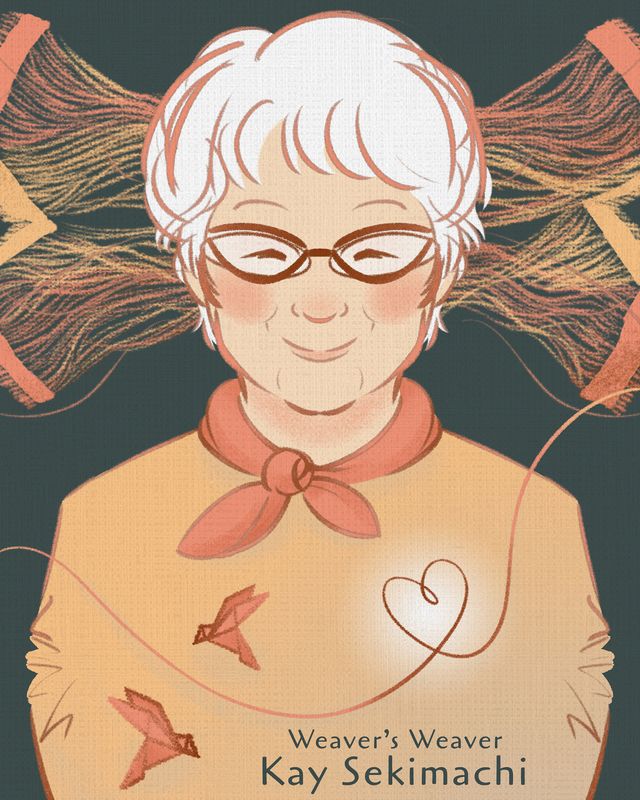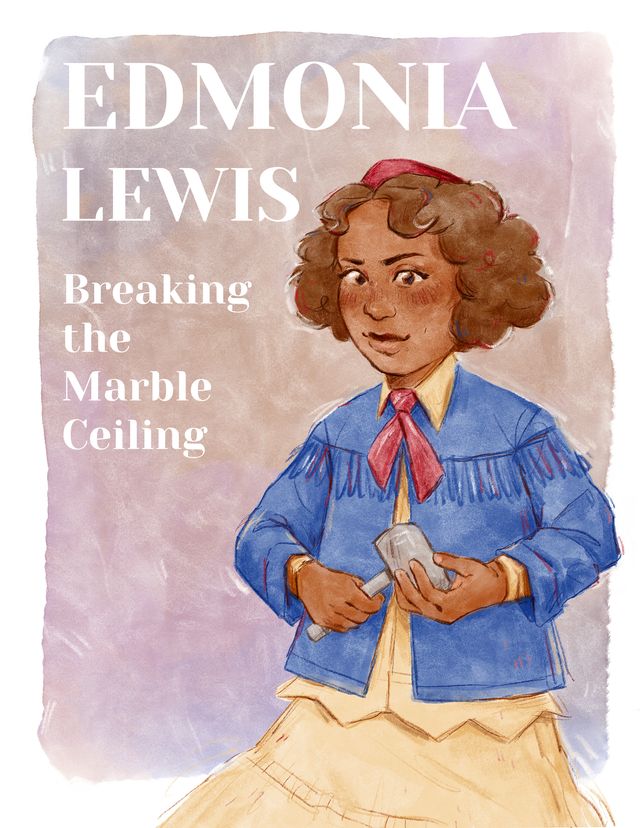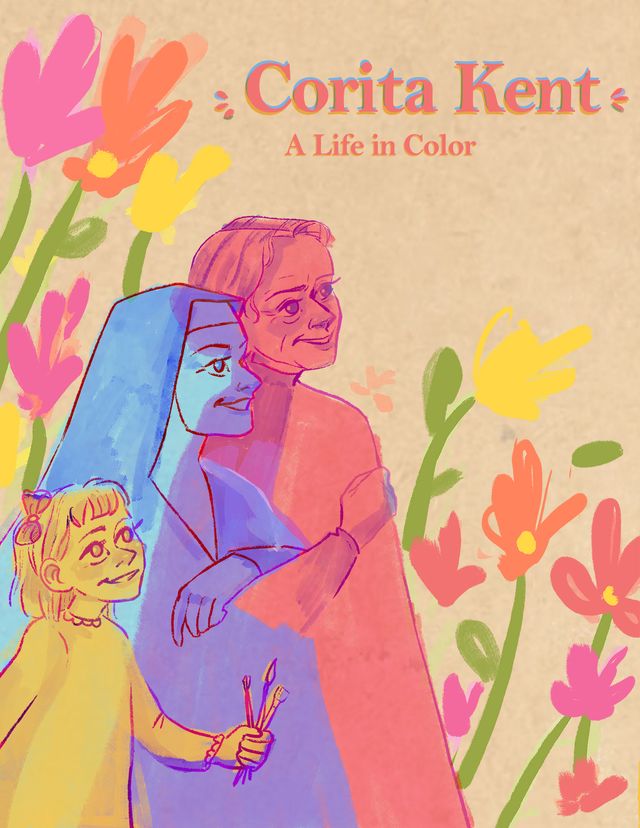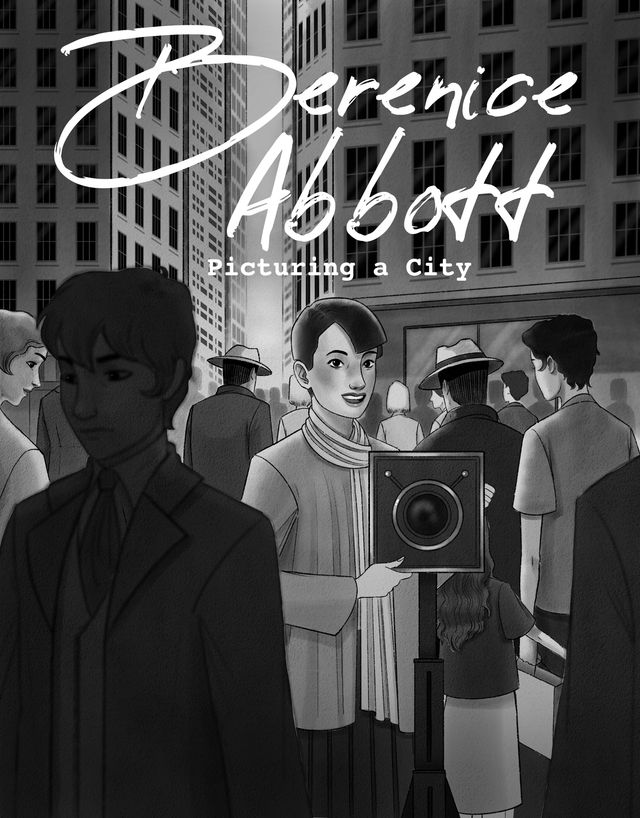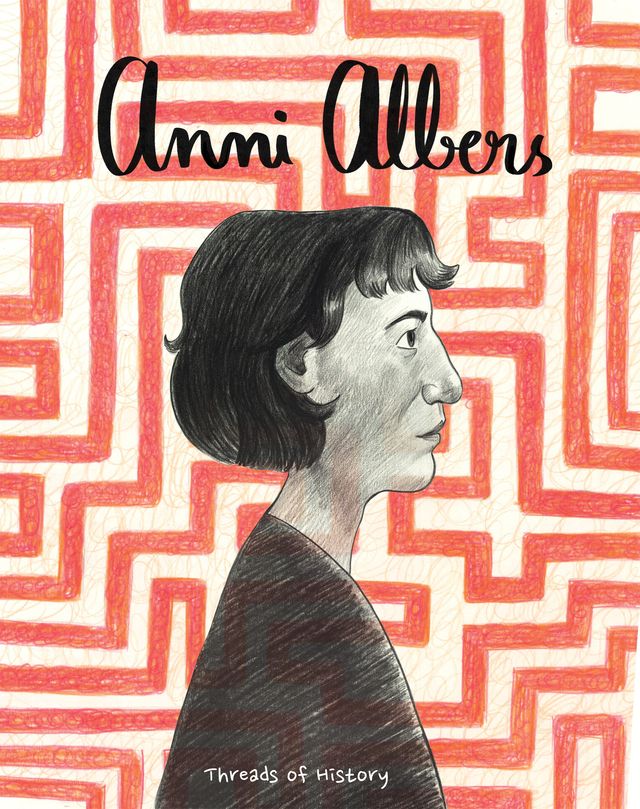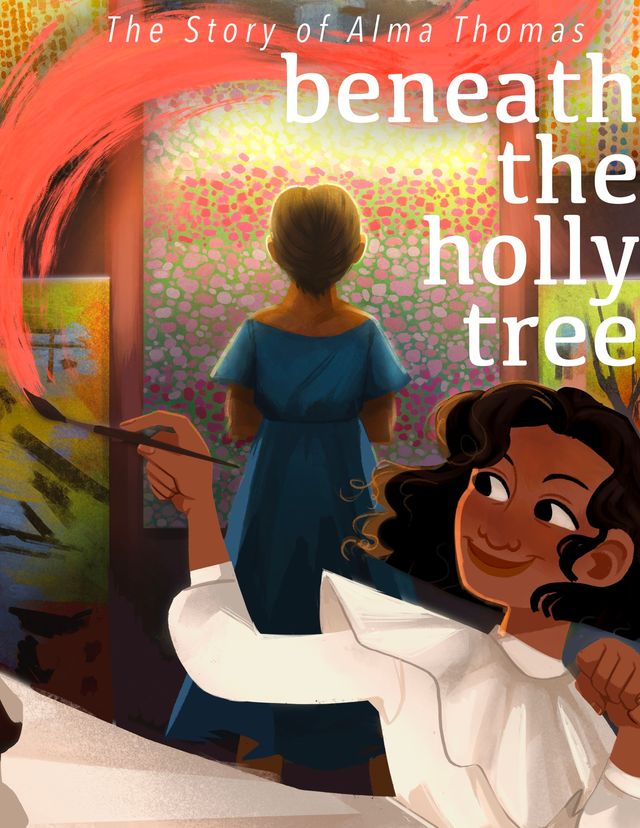An Overview
Born to Mexican American parents and raised in a house of women, Judy Baca grew up proud of her heritage. She tells stories of underrepresented communities, giving voice to women, the working poor, LGBTQ+, people of color, and immigrants.
This comic is part of a series Drawn to Art: Tales of Inspiring Women Artists that illuminates the stories of women artists in the collection of the Smithsonian American Art Museum. Inspired by graphic novels, these short takes on artists’ lives were each drawn by a student-illustrator from the Ringling College of Art and Design.
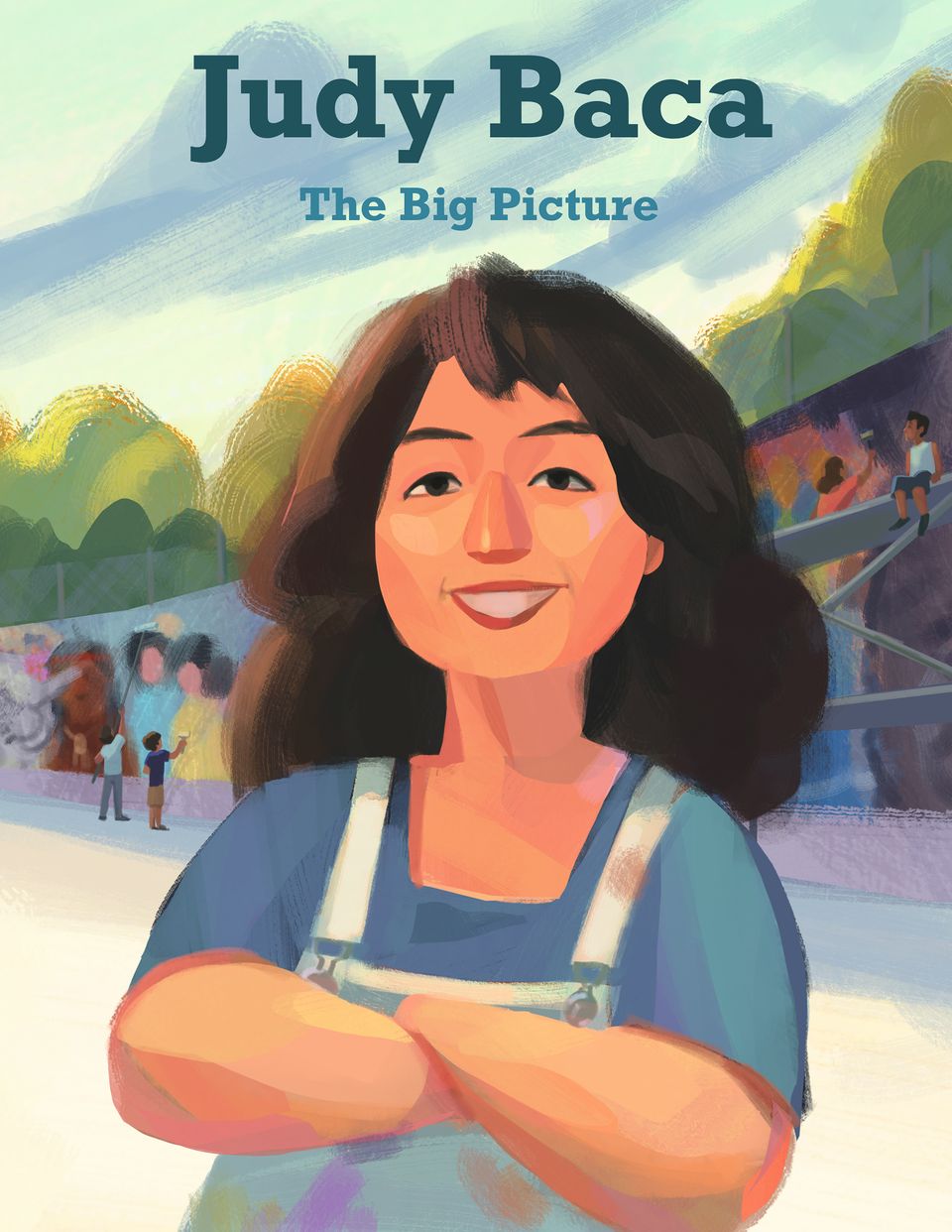
Judy Baca stands in the foreground with her arms crossed confidently and a wide smile. She has a warm glow on her medium brown skin, as well as dark brown hair that flows just behind her shoulders. She is wearing a dusty blue, short-sleeved shirt with paint-stained white overalls. Behind her is a long wall with children and adults painting a colorful mural outdoors; while three of the people stand while they work, one young person in a white tank top and shorts sits on the scaffolding that has been constructed as part of the mural creation process. Behind the wall are lush green trees and a blue sky. Above Judy, the title of the comic reads: “Judy Baca” with a subtitle, “The Big Picture.”
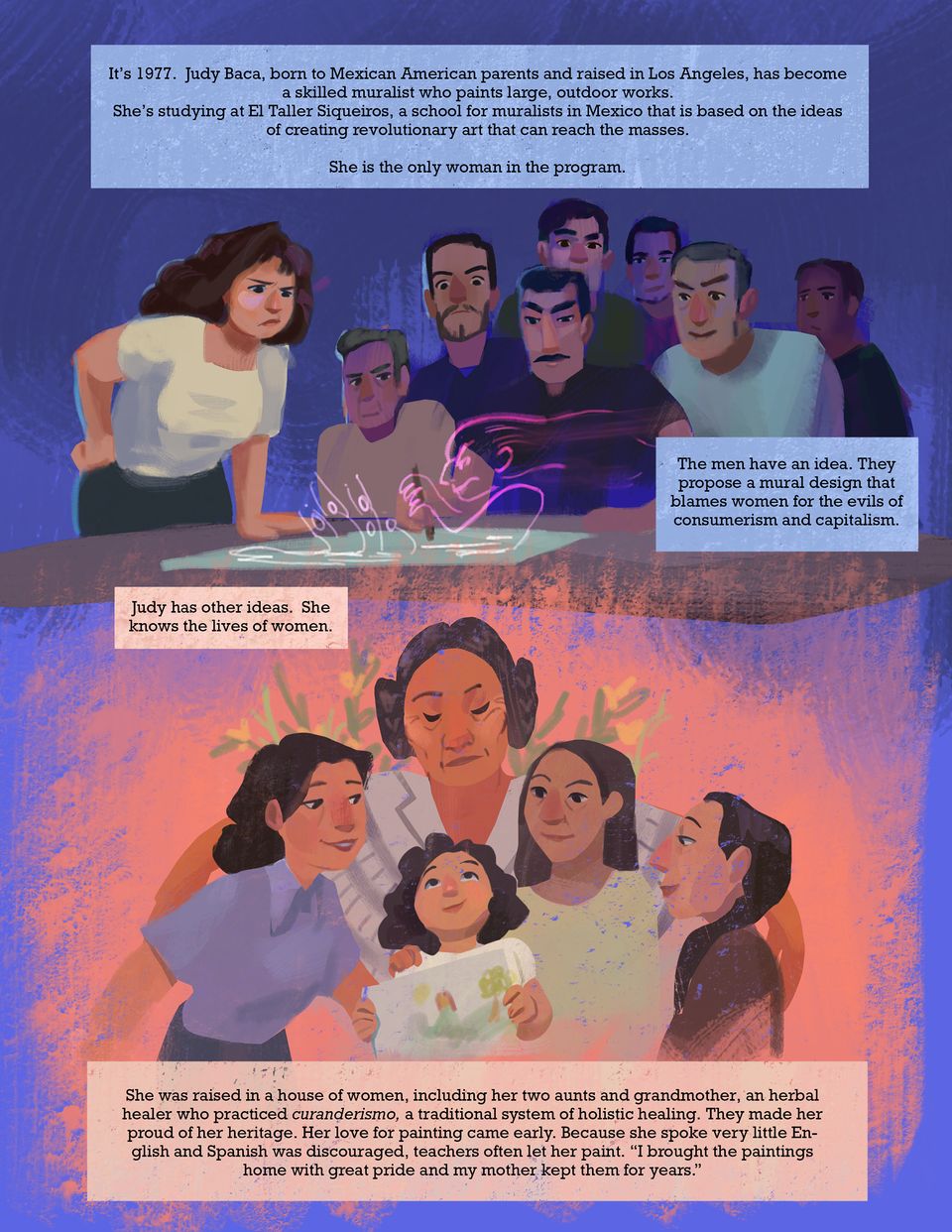
The page is split into two illustrated panels, each taking up half of the page.
Panel 1:
Judy stands to the left with a hand on her hip, leaning over a table to look at a sheet of paper. Her other hand is leaning on the table. She is wearing a white, square-neck shirt and dark black-green pants. Her long brown curly hair falls below her shoulders. She has a distraught look on her face. To the right of Judy is a group seven men all clumped together looking at the sheet of paper. The man in the front is drawing on paper. The drawing seems to come to life as it glows pink; it pictures an evil-looking woman scaring a crowd of people. The illustration is painted with textured brushes and cool tones. At the top, text reads:
“It's 1977. Judy Baca, born to Mexican American parents and raised in Los Angeles, has become a skilled muralist who paints large, outdoor works. She's studying at El Taller Siqueiros, a school for muralists in Mexico that is based on the ideas of creating revolutionary art that can reach the masses. She is the only woman in the program.”
To the lower right of the panel, text reads:
“The men have an idea. They propose a mural design that blames women for the evils of consumerism and capitalism.”
Panel 2:
A group of four women surrounding a young Judy. She has dark brown, curly hair and is holding one of her drawings. She looks up at her grandmother, whose arms wrap around the entire group of women. The grandmother has gray hair in two braided buns on the side of her head. She wears a white blouse and looks down proudly at Judy. The three other women all have dark brown hair and kind smiles, and they surround her and gaze at Judy with love. Behind the group of women is a warm halo of pink brush strokes. To the upper left of the panel, text reads: “Judy has other ideas. She knows the lives of women.”
Under the group of women, text reads:
“She was raised in a house of women, including her two aunts, and grandmother, an herbal healer who practiced curanderismo, a traditional system of holistic healing. They made her proud of her heritage. Her love for painting came early. Because she spoke very little English and Spanish was discouraged, teachers often let her paint. ‘I brought the paintings home with great pride and my mother kept them for years.’”

This page is again split into two halves. In the top illustration, Judy is again shown with the same group of men as on the previous page, but instead, she stands firmly in front of them. She leans over the table with a pencil in her right hand, etching in a drawing that seems to come to life as well in a pink glow. The drawing includes a variety of figures leaning to the left with their fists raised high in the air. Judy has a determined look on her face, while the men behind her look pleasantly surprised as they curiously examine her drawing. The scene feels slightly warmer in tone and includes a pink gradient behind Judy and the group of men. To the upper left, there is a text box that reads:
At the workshop in Mexico, she designs an earlier version of her mural Uprising of the Mujeres.
Below the illustration is another text box that reads:
"It features a powerful Indigenous woman who leads both men and women workers in an uprising against exploitation ... a woman who reminded her of the Indigenous women in her own life, especially her grandmother."
In the lower illustration, a crowd of people gazes to the right to observe Judy’s mural, Uprising of the Mujeres. The mural includes a focal point of a Chicana woman lying down, pointing to the left of her. Behind her is a scene of fields, mountains, and industrial buildings. The mural looks to be displayed in a gallery exhibit, with a warm light illuminating the painting. To the lower right of the illustration, there is text that reads:
"Uprising of the Mujeres and Baca's community projects speak to the transformative power of art, both political and personal. 'I wanted to tell the story of the history that wasn't recorded in history books. The history of people of color, the history of women, of Indigenous people. To look at what was missing from the story of America.'”
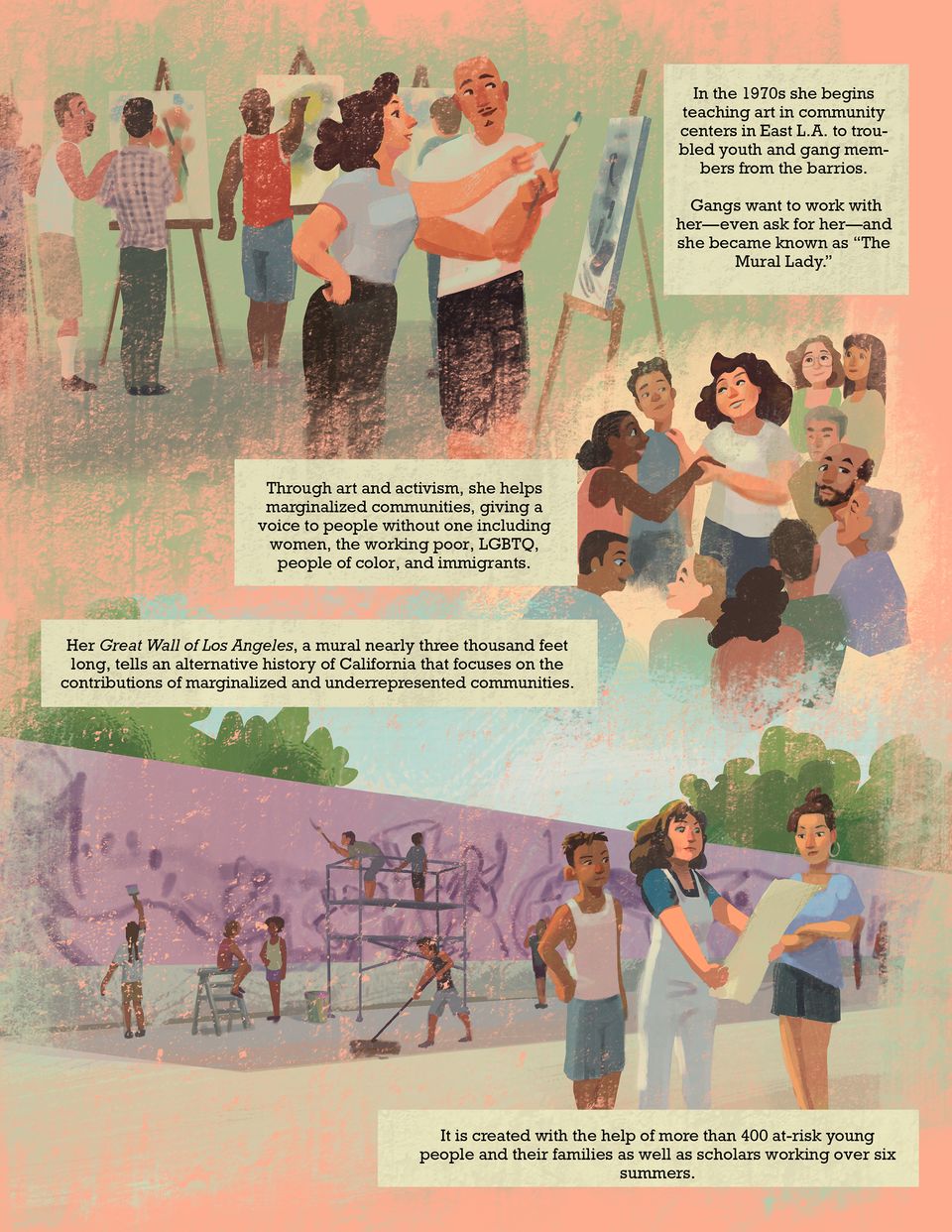
This page includes three vignetted illustrations on top of a warm peach background. The first is in the top left corner and depicts Judy teaching a group of men how to paint. She faces the right towards a man’s easel, pointing at the painting with one hand on her hip. The man looks curiously at the painting, taking in her advice. To the right of the illustration, there is text that reads:
"In the 1970s she begins teaching art in community centers in East L.A. to troubled youth and gang members from the barrios. Gangs want to work with her -even ask for her-and she became known as 'The Mural Lady.'"
The second illustration is below that text and depicts Judy being surrounded by a crowd of admirers. The crowd is diverse in race, ethnicity, gender, and age. She looks to the left as she shakes the hand of a young Black woman who looks at her with admiration. She places her other hand on the shoulder of a young boy who appears to be of Hispanic descent. The rest of the crowd includes young teens and older women of all different backgrounds who face Judy. To the left of the illustration, there is text that reads:
"Through art and activism, she helps marginalized communities, giving a voice to people without one including women, the working poor, LGBTQ, people of color, and immigrants."
Under that box of text, there is another that reads:
"Her Great Wall of Los Angeles, a mural nearly three thousand feet long, tells an alternative history of California that focuses on the contributions of marginalized and underrepresented communities."
Under the text box Is an illustration of Judy holding out a drawing to show to two young teens standing on both sides of her. Judy wears the same blue shirt and white overalls as she does in the cover illustration. Behind them is a group of teens etching the mural on a wall. They reach up with long paintbrushes and stand on ladders and tall shelves to reach across the entire wall. Behind the wall are lush green trees and a blue sky. Below Judy is a text box that reads:
"It is created with the help of more than 400 at-risk young people and their families as well as scholars working over six summers."
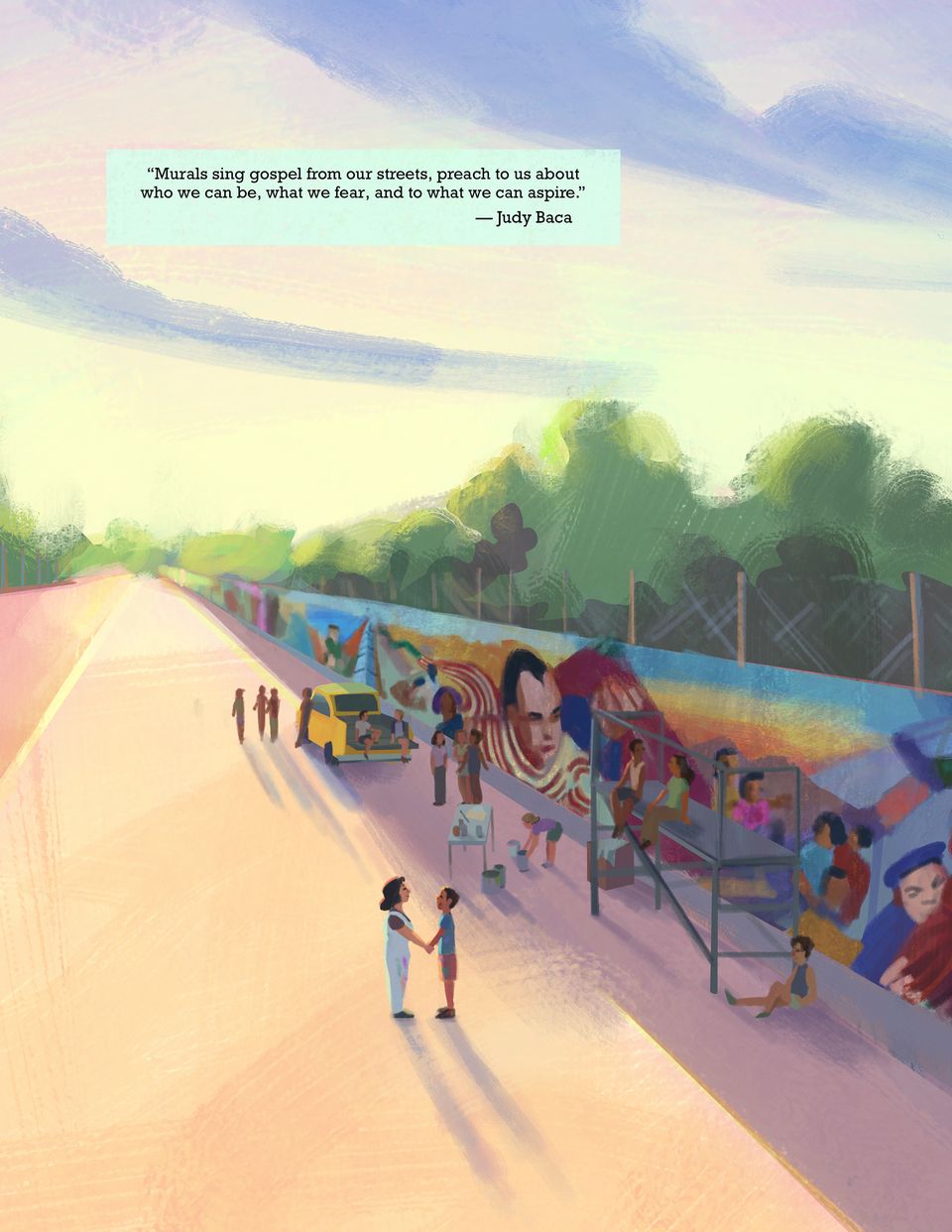
This page includes a full-page illustration looking down on The Great Wall of Los Angeles reaching into the distant horizon. Because the sun is setting, there is a warm atmosphere in the environment, with cool shadows stretching across the road. There is a wide range of pinks and oranges used to highlight the warmth of the environment. The mural looks to be nearly complete, with lush trees growing behind it. The painters sit in the shadow cast by the wall after a long day of painting. In the sunlight is Judy shaking the hand of one of the young painters. In the sky, there is a quote from Judy that reads:
"'Murals sing gospel from our streets, preach to us about who we can be, what we fear, and to what we can aspire.'"
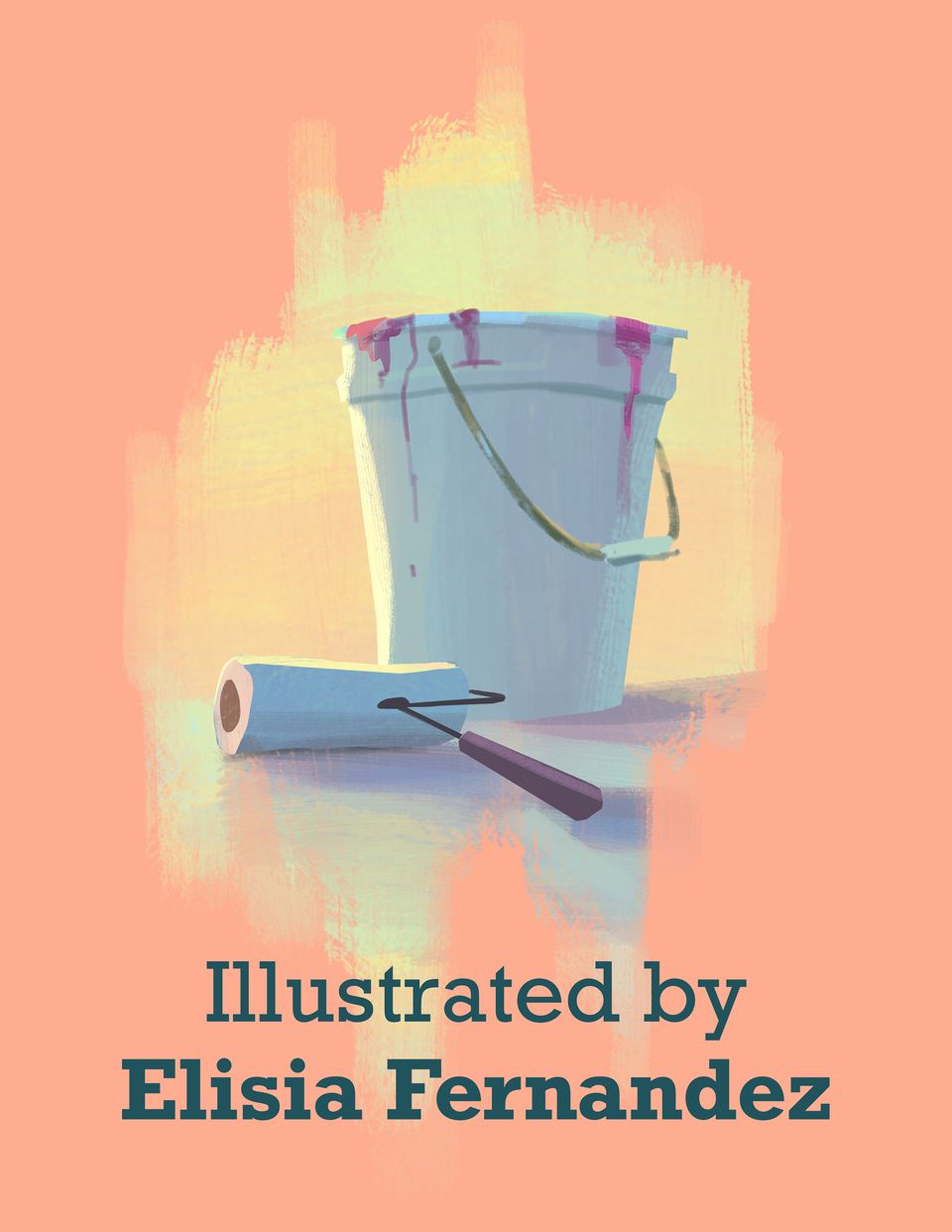
On a coral pink background, there is a simple painting of a paint roller laying next to a paint bucket. There is pink paint stained on the rim of the bucket. There is a warm yellow light behind the objects, giving them a glowing rim light. Below the small illustration is text that reads:
Illustrated by Elisia Fernandez














